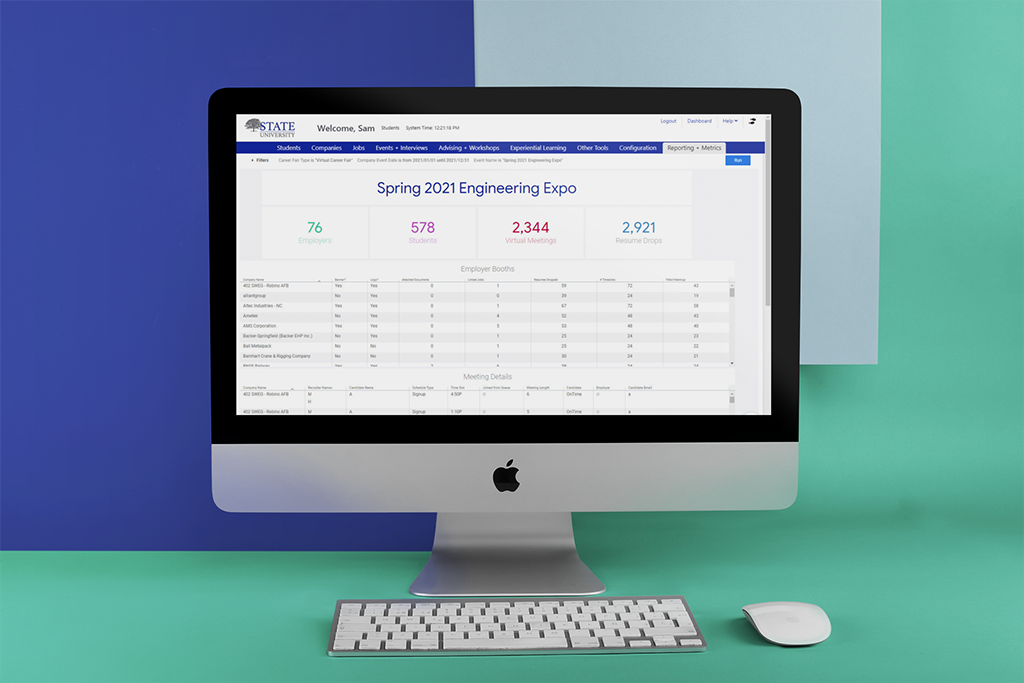
Virtual career fairs and online recruiting events have become the best way for employers to connect with job seekers today. It’s not only more cost effective than in-person events, but also easier to participate, safer, more convenient, more efficient and easier to track to ROI. The ROI of any event is directly related to participation and attendee satisfaction. For a career fair, that means hosting an engaging event that captures the attention of job seekers and allows employers to show off their company culture and career opportunities. Here are some key metrics to track to help you increase satisfaction and engagement from one event to the next:
BEFORE THE EVENT
Attendee Interest
Prior to the start of your career fair, schools should be communicating with students and employers to inform them about the upcoming event and encourage them to attend. Schools should be posting on their website and social media, sending out emails and texts, and posting flyers around campus to get the word out about the event. The more people know about the event, the more attendees there will be. Stay on top of email open rates, social media post views, click-through rates, and website traffic to see what’s working and what’s not.
Registrations
Before the start of the event, track the number of students and employers that signed up and plan to attend the event. Not only track the number of employer booths but also the number of recruiters in each booth and the number of students who’ve already signed up for timeslots to meet with those employers. Not all registrants will show up, but the higher number of registrations, the higher expectations you can have for day-of attendance.
Sources of Traffic
Tracking the total number of registrants doesn’t tell you enough. Take the extra step to find out where each registrant came from and why with a simple “How did you get here?” registration dropdown question. Did they sign up through a link from an email? Did they visit your website and decide to register? Or did your social media post, friend or advisor convince them to attend? You can also ask “Why are you registering?” to find out more. Was it the list of attendees, a specific feature of the event, or something else that caught their attention? Understanding how and why people registered for the event will tell you what communication efforts were most effective and allow you to use those for events in the future as well.
Preparation
With a virtual event, it’s easier to see how much effort students or employers are putting into preparing for the event. Have the employers fully setup their booths with custom content, logos, banner images, linked jobs and uploaded other resources for job seekers to view? Have students logged in prior, completed their job seeker profile, favorited companies of interest, and uploaded or dropped their resume for employers? Do some companies have more interest than others? If so, find out what they did prior to event that differentiated them from other employers and share that best practice tip with future employers.
DURING THE EVENT
Engagement
Tracking the level of engagement at your event will tell you how effective it was. How many virtual meetings actually took place between students and employers? Track the total number of visits to each booth and meeting length to see which companies stood out to job seekers. Also be sure to track the number of filled meetings versus open timeslots. A high number of booth visits and longer meeting times typically translates into a positive visit with a company. Determine which companies had the most visitors to see which industries are the most popular among job seekers and determine if you’re targeting the right audience.
Content of Interest
In a virtual environment it’s not only easy to track what companies students are most interested in but also what types of content they engaged with the most. Don’t just track how many meetings occurred but also how many students wanted to learn more about opportunities and career paths at companies by viewing the linked jobs and resources. This will tell you what your students are most are interested in so you can encourage employers to share similar content at future events.
Support Needed
Keep track of the number of visitors to the career center booth and what they asked for to discover if students needed a lot of help or extra direction. Figure out the most frequent questions and concerns to determine areas of improvement for the future. At your next event, include these FAQs and other relevant resources in the “before, during and after content areas” either in your event lobby or within your career center booth.
AFTER THE EVENT
Attendance
This is probably the most obvious metric, but once your virtual career fair is over schools should track the number of logins to see how many people actually attended. Discover how many of those logins came from students versus employers and compare that to the total number of registrations. This will tell you how many people planned on attending but didn’t show up. Use those lists to send follow-up surveys to both attendees and non-attendees.
Satisfaction
Don’t be afraid to ask for feedback! Send follow-up surveys to employers and student attendees to find out what they liked about the event and how it could be improved. Ask about overall satisfaction but also dive deeper into key areas to understand if it was the technology, number of meetings, types of attendees, or other factors that affected their experience. You should also survey registrants who didn’t show up for the event and find out why.
Monitoring these key metrics will ensure your virtual career fairs are successful plus help you improve online hiring events in the future. Need help? GradLeaders makes this easy with at-a-glance metrics and real-time reporting tools. Contact us to learn more about our virtual career fair solutions or for other best practice advice.
